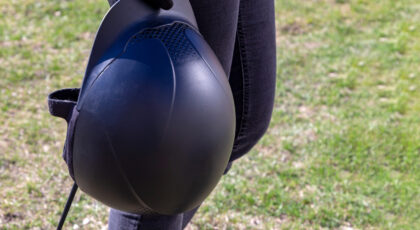So you’re going to buy a new horse—congratulations! This is one of the most exciting and anticipation-filled moments of your riding career. You’ve narrowed down the candidates. You’ve found the best fit. And now, it’s time for that crucial, final hurdle: the vet check.

Dr. Jonathan Yardley (via twitter.com/@docyardley)
If you’ve been in horses long enough and have already owned a few of them, then you know the pre-purchase exam can be a confusing, stressful, expensive and often heartbreaking process. (Seriously, don’t get attached until after your vet gives the thumbs up.) Fortunately, Jonathan Yardley, DVM and assistant professor of Equine Practice at Ohio State University, understands that the pre-purchase exam can be all this and more. That’s why his talk at the 2016 Equine Affaire in Ohio was so useful. From your rights as a purchaser to the components of a vet check and what you’re really paying for, here are Dr. Yardley’s tips for getting the most out of your pre-purchase exam.
So let’s talk pre-purchase exams: what are they for and what do they include?
“A pre-purchase exam is more than your average vaccination exam,” says Yardley. “We’ll look at the eyes and teeth, listen to the heart and lungs, take a temperature, and watch the horse do their job.”
The performance part of the pre-purchase follows the regular health exam. Your vet will begin by palpating the horse’s tendons and joints—the stifles, hocks, and fetlocks, right on down to the feet, where your vet will check out the quality of the horse’s latest shoeing job. He or she is looking for things like excessive fluid on the knees, bumps or thickening in the tendons, or effusions in the skin. This process also helps vets detect old surgery scars, which may indicate significant veterinary procedures such colic or throat surgery, or even nerving.
Next up: the flexion test.
No, your vet isn’t lifting legs for the fun of it. Joint flexions provide him with an important diagnostic tool for soundness. “We’re going to flex each joint individually for 30 seconds to 60 seconds and then watch the horse jog off. That’s part of our lameness exam, and it’s telling us if there are any stresses in the joints or early arthritis that could be occurring.”
Yardley says that each vet has their own method for scoring flexions, which they rate as either negative (that’s a good thing!) or positive, meaning there’s some degree of lameness—often visible as shorter steps or strides—present. “When you think about yourself walking, and you have a little stick in your shoe, you’re like, ‘Ow, that hurts,’ so you’re going to land heavier on your sound leg. So when we flex the horses off, we’re looking at that degree of lameness, or degree of change that we’ve caused the horse.”
After the horse is flexed, your vet will often want to see him working through various gaits on the lunge line, and then under tack. If the horse is meant to be an eventer, hunter or jumper, the veterinarian may also wish to watch him jump a few fences, or may ask to see a recent video.

(flickr.com/lostinfog)
Okay, lay it on me. So far, what are we looking at cost-wise?
There’s no denying it: pre-purchase exams cost money—and that price can go up considerably depending upon how much diagnostic work you want to consider (think X-rays, ultrasounds, and MRIs). How much you spend will be determined by your overall budget, what you’re buying, and how much risk you’re willing to accept. “For a basic exam, it’s about $300-$350, that’s without X-rays. So that’s a really good value for what you’re getting,” says Yardley, adding that, on average, most pre-purchase exams with X-rays should take up to three hours, with a full hour spent on the physical and lameness exams, and an in-depth report provided after the checkup. “If you’re paying less than that, you’re probably getting less time spent on the horse. Price does make a difference,” he says.
What about X-rays?
Depending on the results of the flexion and performance parts of the pre-purchase, your vet will likely recommend X-rays. The good news? These can provide a clearer picture of any issues going on in the horse’s joints. The bad news? They aren’t cheap. Each picture costs an average of $40, meaning for each joint (hocks, stifles, fetlocks, feet, etc.), you’re looking at about $160. To X-ray the whole horse, you’re looking at something in the neighborhood of $1,600.
“If you’re even going to buy a horse for, say, $4,000-$5,000 and you’re going to spend 10% of what the horse is worth on a pre-purchase exam, it’s really worth the money. The best example I have is the people who buy a horse without a pre-purchase exam, spend $5,000 or $10,000, and they have a $5,000 lameness afterward. The horse was sound when they rode it, so they didn’t have anyone come look at it and now the horse has really bad navicular, or something similar.”
Note to self: this is a pre-purchase exam, NOT a lameness exam.
If something significant turns up on the performance or X-ray portion of the pre-purchase exam, Yardley says, it’s time for a serious reality check. “If the pre-purchase exam turns into a lameness exam, I’d pack up my stuff and go home. If a horse is lame on day one, I wouldn’t want to buy that horse, and I’d hope my client wouldn’t want to buy that horse. Don’t take the trailer with you on the pre-purchase day, don’t get emotionally involved with the horse. If the horse is lame, the horse is going to stay lame. This is not a lameness exam.”
Another thing to consider: this is your exam. If a pre-purchase exam turns into a lameness exam, Yardley says, the seller is getting a free lameness exam out of the deal. “When you hire us to do a pre-purchase exam, we’re working for you and only for you. And the information that we gather on this exam is your information and your information only. You do not have to disclose that back to the seller of the horse. It’s yours, you can do with it what you like.”

(flickr.com/Pete Markham)
What other parts of the exam can be trouble spots?
Yardley recommends a good, sedated dental examination as part of the pre-purchase, especially if you’re considering an older horse. “[People] drink coffee and eat ice cream, so you know when you eat something that’s a little more sensitive that your teeth hurt,” he says. “Horses don’t really show tooth pain very well until it’s very severe. An older horse is probably going to have poorer dentition, and if you’re buying a 20-to-25-year-old horse, getting in their mouth and doing a full exam is going to help determine what kind of hay and diet you put them on.”
A thorough ophthalmic exam is another critical aspect of the process. “Horses are very visual creatures,” says Yardley, adding that horses with vision impairment (such as cysts or scars in the eye) can often be spooky, while other issues, such as Equine recurrent uveitis (ERU) can develop into chronic, expensive conditions down the road. Additionally, if you are buying a mare or stallion and have plans to breed him or her, Yardley recommends having a reproductive exam with a specialist who can tell you if the horse is capable of producing and/or carrying a healthy foal to term.
Finally, your vet might also recommend drawing blood for a drug screening test, which typically costs an additional $300-$400. These results can be run immediately if there’s cause for concern, or, Yardley suggests, some vets will give you the option of saving the samples. These can always be run later on if behavioral problems arise, but will save you a little money in the short-term on the pre-purchase exam.
How do I choose a veterinarian to conduct the exam?
Conflict of interests does exist in the horse world, and the last thing you want is to become an unwitting victim. “I’m not saying that vets are unscrupulous, but you need to be careful,” says Yardley, “especially if it’s a vet that does a lot of work for that farm, there could easily be a conflict of interests.”
Also worth noting: a seller is under no legal obligation to disclose medical facts about the horse before or during a pre-purchase exam—even more reason why you need to trust that the vet you’re using has your best interests at heart.
“You really want to have a veterinarian perform the exam that is either your veterinarian or a veterinarian that has never worked on the horse before. If you’re buying a horse in a new area, I would look around to see who the other vets are. If a [seller] is recommending such and such a vet, and you don’t know the area, sometimes you have to be a little leery. So ask your veterinarian if they know or could recommend someone in that area as a third party.”

So what if something does show up on the exam. How do I know what’s deal-breaker and what isn’t?
Some horses will pass their vet checks with flying colors. But for many others, there’s usually a small health hiccup or two that need to be addressed. Take something like slight arthritic changes in the hocks, one such hiccup commonly seen in the X-rays of sport horses or former racehorses, such as the 13-year-old Standardbred used in Yardley’s Equine Affaire demonstration. “He’s done hard work—this horse has raced 197 times—so to have a little hock arthritis is not really a big deal in my mind,” says Yardley. “But if you don’t feel comfortable with that, then that’s something you need to know to make an educated purchase.”
Yardley advises caution, however, when working with a seller who advertises their horse with the caveat that he requires injections to be sound. “You need to know what that entails and why it’s being done. You know you need to medicate the condition, which is good to know, but you need to know what’s going on in the joints themselves.”
Ultimately, making the right decision about a horse you’re considering is a matter of having all the information available to you at your disposal, and working with a veterinarian who can help put that information into perspective. “You have to know what you’re willing to live with and what you’re not willing to live with,” Yardley says. “If you have a good report with your veterinarian, [he or she] can give you a good idea about the risks associated with buying a particular horse.”
More awesome veterinary stories, right this way…


 August 9, 2016
August 9, 2016 

























